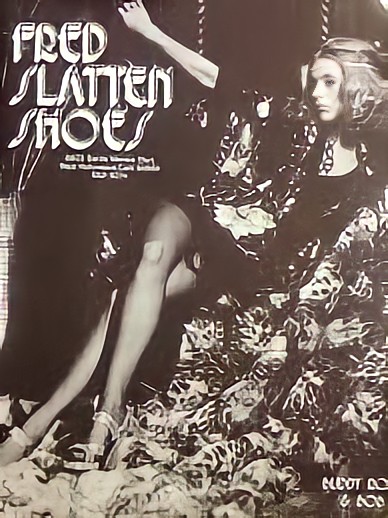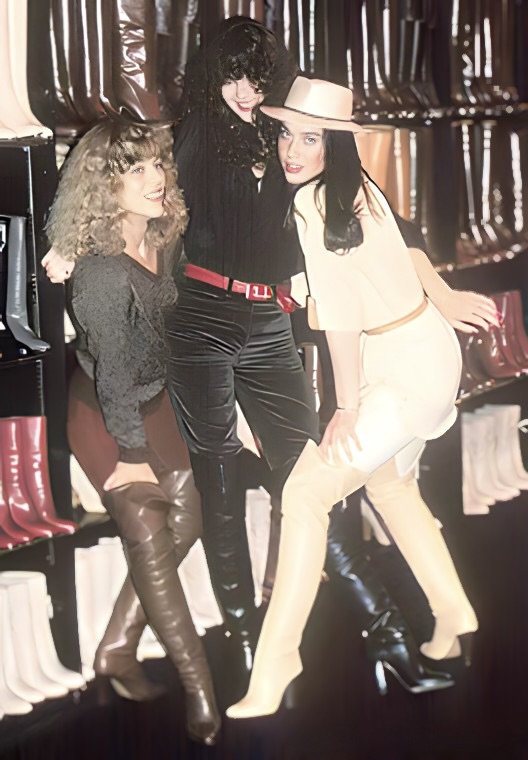Cher, Diana Ross, Prince, Marvin Gaye, Barbara Streisand, Goldie Hawn, Liza Minnelli. Pick a name from that era, and they too likely shopped at Fred Slatten Shoes, a boutique he kept lit 24 hours a day with the display windows showing off spinning turntables of his platform designs.
By TONY CASTRO
THEY USED TO CALL FRED SLATTEN the King of Santa Monica Boulevard in West Hollywood in the years just after the 1960s had begun transforming pop culture in America.
Slatten wasn’t a musician or an actor. He didn’t direct movies or represent stars. He did own a gorgeous bronze and gold Rolls Royce that became synonymous with him in the years that he was a fixture in an unincorporated West Hollywood trapped at the time between the glitz of Tinseltown and the exclusivity of Beverly Hills.

A tall, lanky former college basketball player at Kansas State, Fred Slatten became famous and rich for designing a product that he himself would never need – platform shoes, which became the rage for stars, celebrities and everyone trying to dress like them at a time when Hollywood lived on glam rock at its shaggiest.
One of the most prominent American shoes designers of his time, Slatten also designed boots – and those sexy, above-the-knee boots Nancy Sinatra sang about in her 1966 hit “These Boots Are Made for Walking” were Fred Slatten creations.
“Nancy Sinatra,” Slatten later recalled in one interview, “was our biggest customer.”
Friendship aside, though, Nancy couldn’t talk Slatten into selling her his personalized “FS 1” license plates from his Rolls Royce that she desperately wanted as a gift for her father Frank.
Cher, Diana Ross, Prince, Marvin Gaye, Barbara Streisand, Goldie Hawn, Liza Minnelli. Pick a name from that era, and they too likely shopped at Fred Slatten Shoes, a boutique he kept lit 24 hours a day with the display windows showing off spinning turntables of his platform designs.

“Before we knew it,” he once said, “we had a captive audience.”
Originally from Kansas City, MO, Slatten had been an executive at Bullock’s and later a wholesaler before deciding to design women’s shoes full-time.
His store at 8803 Santa Monica Boulevard was among a collage of unique boutiques, coffee shops, restaurants and hip businesses around the corner from Larabee Sound Studios in the years before West Hollywood became a city.
Stars and celebrities poured into Slatten’s boutique, but in an interview with the Los Angeles Times, Slatten recalled that actress Lana Turner had been “the only customer we kept the store open late for.”
“Then there was this little pudgy guy who turned out to be Elton John,” he said. “He bought every shoe we ever made.”
Slatten also had a special armoire in his store that was filled with nothing but platform shoes and boots made especially for singer Stevie Nicks.
“When Stevie needed a new pair, she would call Fred, and he’d have them sent overnight to her no matter where she was in the world,” recalled Becky Cash, who was like an adopted daughter to Slatten and the longtime manager of his store.

The boutique became a magnet for men shopping for girlfriends, as well as women, because Slatten took pride in hiring the most beautiful sales assistants he could find.
“Gene Simmons from KISS came in a lot,” Slatten told one interviewer, “but I think he just liked our girls.
“Every centerfold for 15 years wore our shoes. Barbi Benton wanted a pair that lit up, so we powered them by batteries.”
At one point, Slatten’s shoes showed city skylines or the faces of David Bowie or Marilyn Monroe, while other platform shoes had real goldfish in their wedges and live birds in their heels.
But as West Hollywood transformed, with cityhood in the mid-1980s and a revamped image on the boulevard, the demand for Slatten’s specialized shoes changed, as well. He closed his boutique, continued designing shoes for others and eventually retired.
He also didn’t think much about today’s platform renaissance, saying they were “kind of gross looking.”
“Our shoes,” he said of his designs, “flattered the foot.”
Most recently Slatten had been working on his memoir about his time and role in Hollywood and his place and its pop culture.
His time, like everyone’s, had come and gone, he used to say.
On July 1, 2015, he died in his sleep at his home. He was 92.
A weeek later friends gathered at the Hollywood Forever Cemetery along Slatten’s beloved Santa Monica Boulevard where his ashes were scattered among the graves of Johnny Ramone, Cecil B. DeMille, Jayne Mansfield, Rudolph Valentino, Douglas Fairbanks and hundreds more of Hollywood’s greatest stars.
The King of Santa Monica Boulevard had come to his final resting place.
Tony Castro, the former award-winning Los Angeles columnist and author, is a writer-at-large with the LAMonthly. He can be reached at tony@tonycastro.com.





